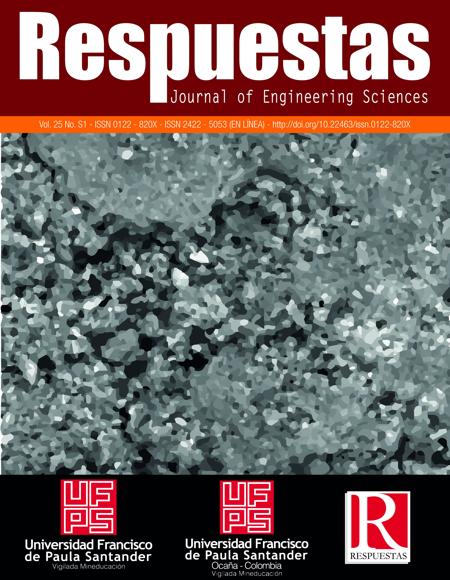Vibrational Spectroscopy as an Alternative for the Discrimination of Illicit Drugs Seized in the City of Cúcuta
Espectroscopia Vibracional Como Una Alternativa Para La Discriminación De Drogas Ilícitas Incautadas En La Ciudad De Cúcuta
Main Article Content
The infrared spectroscopy with Fourier transform coupled to attenuated total reflectance (ATR-FTIR), is being used for the identification of illicit drugs, being an alternative to the method of Gas Chromatography with flame detector or selective mass detector. Additionally, the technique standardized by forensic laboratories for the analysis of seized drugs does not allow differentiation between the two forms of cocaine (base and hydrochloride) marketed. In this investigation, four hundred (400) samples seized in the city of Cúcuta during the period July 2017 to June 2018 were analyzed by the ATR-FTIR technique, performing SNV (Standard Normal Variate) and second spectrum-derived treatment for the discrimination between cocaine base and cocaine hydrochloride forms, in mixtures with phenacetin, caffeine, lidocaine, levamisole adulteration, as well as the presence of lactose and sodium bicarbonate as diluents. A linear discriminant analysis (LDA) model was implemented in order to differentiate the types of cocaine in more complex matrices or adulterants different from those included in the study. 100% of the samples were correctly discriminated and the methodology was validated in two spectrophotometers that were in different environmental conditions of different references.
Downloads
Publication Facts
Reviewer profiles N/A
Author statements
Indexed in
- Academic society
- Universidad Francisco de Paula Santander
- Publisher
- Universidad Francisco de Paula Santander
Article Details
N. Kumar, A. Bansal, G.S. Sarma, R.K. Rawal, Chemometrics tools used in analytical chemistry: An overview, Talanta. 123 (2014) 186–199.doi:10.1016/j.talanta.2014.02.003.
M. Bovens, B. Ahrens, I. Alberink, A. Nordgaard, T. Salonen, S. Huhtala, Chemometrics in forensic chemistry — Part I : Implications to the forensic work fl ow, Forensic Sci. Int. 301 (2019) 82–90.doi:10.1016/j.forsciint.2019.05.030.
UNODC, Executive summary — Conclusions and policy implications, in: World Drug Rep. 2018, Vienna, 2018: pp. 1–31. doi:10.18356/a1062695-en.
O. Kudlacek, T. Hofmaier, A. Luf, F.P. Mayer, T. Stockner, C. Nagy, M. Holy, M. Freissmuth, R. Schmid, H.H. Sitte, F.P. Mayer, R. Schmid, M. Freissmuth, C. Nagy, O. Kudlacek, T. Hofmaier, Cocaine adulteration, J. Chem. Neuroanat. 83–84 (2017) 75–81. doi:10.1016/j.jchemneu.2017.06.001.
J.F. Casale, J.R. Mallette, L.M. Jones, Chemosystematic identification of fifteen new cocaine-bearing Erythroxylum cultigens grown in Colombia for illicit cocaine production, Forensic Sci. Int. 237 (2014) 30–39. doi:10.1016/j.forsciint.2014.01.012.
P. Fagan, M. Tatarkovic, P. Bour, Cocaine Hydrochloride Structure in Solution Revealed by Three Chiroptical Methods, Chemphyschem. 18 (2017) 2258–2265.doi:10.1002/cphc.201700452.
Oficina de las Naciones Unidas contra la Droga y el Delito UNODC, Monitoreo de territorios afectados por cultivos ilícitos 2018, Bogota:UNODC-SIMCI, 2019. https://www.unodc.org/documents/colombia/2019/Agosto/Informe_de_Monitoreo_de_Territorios_Afectador_por_Cultivos_Ilicitos_en_Colombia_2018_.pdf.
V.N. Conceicao, L. Souza, B. Merlo, ESTUDO DO TESTE DE SCOTT VIA TÉCNICAS ESPECTROSCÓPICAS: UM MÉTODO ALTERNATIVO PARA DIFERENCIAR CLORIDRATO DE COCAÍNA E SEUS ADULTERANTES, Quim. Nova. 37 (2014) 1538–1544.
T.S. Grobério, J.J. Zacca, É.D. Botelho, M. Talhavini, J.W.B. Braga, Discrimination and quantification of cocaine and adulterants in seized drug samples by infrared spectroscopy and PLSR, Forensic Sci. Int. 257 (2015) 297–306.doi:10.1016/j.forsciint.2015.09.012.
M. Monfreda, F. Varani, F. Cattaruzza, S. Ciambrone, A. Proposito, Fast profiling of cocaine seizures by FTIR spectroscopy and GCMS analysis of minor alkaloids and residual solvents, Sci. Justice. 55 (2015) 456–466. doi:10.1016/j.scijus.2015.06.002.
J. Broseus, S. Huhtala, P. Esseiva, First systematic chemical profiling of cocaine police seizures in Finland in the framework of an intelligence-led approach, Forensic Sci. Int. 251 (2015) 87–94. doi:10.1016/j.forsciint.2015.03.026.
M. Morelato, A. Beavis, M. Tahtouh, O. Ribaux, P. Kirkbride, C. Roux, The use of forensic case data in intelligence-led policing: The example of drug profiling, Forensic Sci. Int. 226 (2013) 1–9. doi:10.1016/j.forsciint.2013.01.003.
C.A.F.O. Penido, M.T.T. Pacheco, R.A. Zângaro, L. Silveira, R. Zangaro, L. Silveira, Identification of different forms of cocaine and substances used in adulteration using nearinfrared raman spectroscopy and infrared absorption spectroscopy, J. Forensic Sci. 60 (2015) 171–178. doi:10.1111/1556-4029.12666.
N.V.S.S. Rodrigues, E.M. Cardoso, M.V.O.O. Andrade, C.L. Donnici, M.M. Sena, Analysis of seized cocaine samples by using chemometric methods and FTIR spectroscopy, J. Braz. Chem. Soc. 24 (2013) 507–517. doi:10.5935/0103-5053.20130066.
S.T. Hassib, G.S. Hassan, A.A. El-Zaher, M.A. Fouad, E.A. Taha, Quantitative analysis of anti-inflammatory drugs using FTIR-ATR spectrometry, Spectrochim. Acta - Part A Mol. Biomol. Spectrosc. 186 (2017) 59–65.doi:10.1016/j.saa.2017.06.002.



